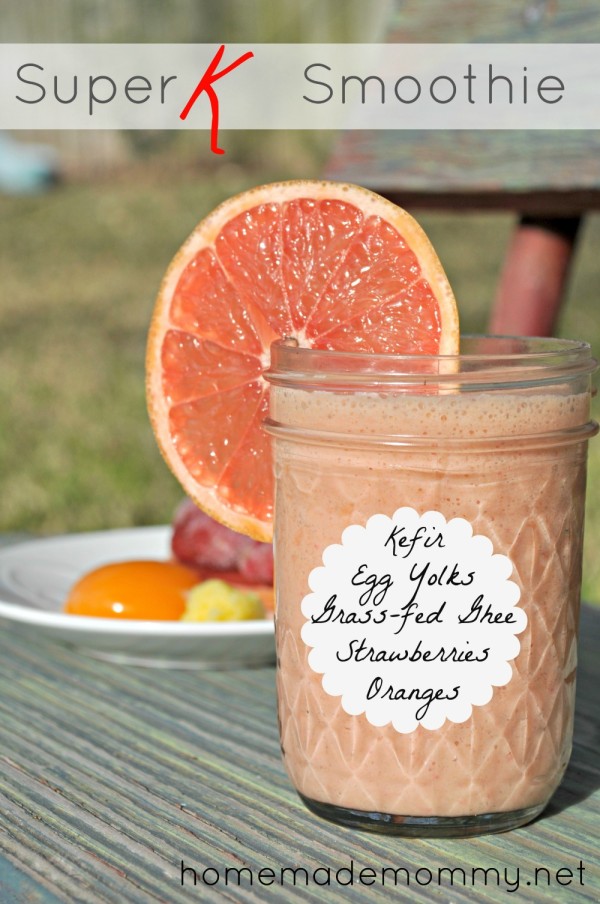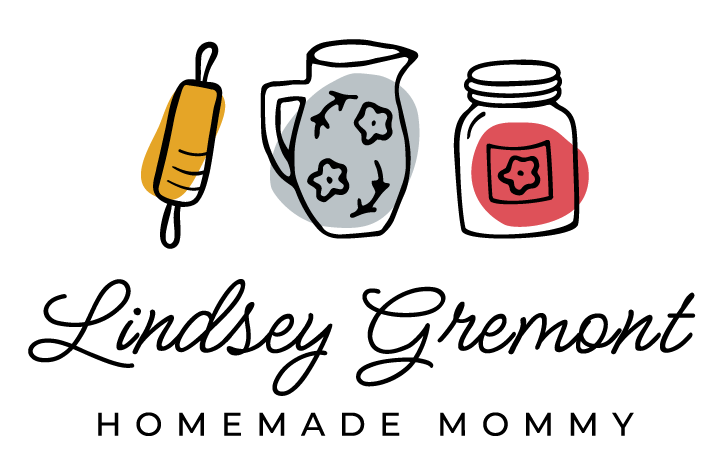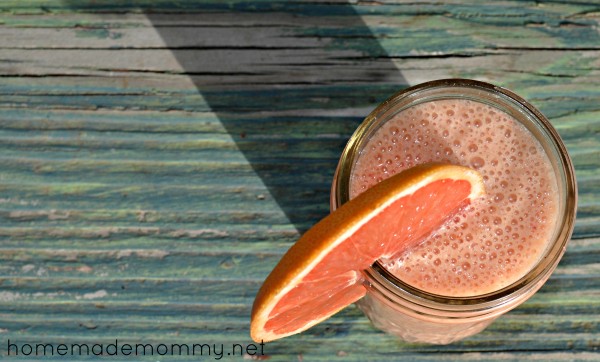Super K2 Smoothie
I recently shared a post highlighting a major missing nutrient in our diets, Vitamin K2. So how do I love to get my K2? Pretty much the easiest way is in what I call my Super K2 Smoothie! This smoothie isn’t full of so called ‘superfoods’ like kale, chia or flax seeds, but it is full of K2. Let’s review: K2 is *only* present in pasture raised animal foods (as MK-4) and bacterial from fermented foods (as MK-7).
Is it a coincidence that all the fermented foods start with the letter ‘K’, as in kefir, kombucha, and kraut?
Even though our top K2 superfood by microgram quantity is hands down natto (a fermented food made from soybeans), I promise this smoothie doesn’t contain natto as this is both hard to source and apparently not too tasty for our Western palates. I would be interested to know if any of you have ever tried natto – please comment if you have and what you thought.
The K2 in this smoothie comes from:
- Pastured egg yolks
- Grass-fed ghee (what is ghee?)(where to buy ghee)
- Kefir (what is kefir?)
A note on kefir: Kefir is most likely a K2 superfood:
Vitamin K2 is a product of bacterial fermentation, so kefir is likely a good source of this nutrient, especially if made with milk from pastured animals. Vitamin K2 plays a key role in calcium metabolism, where it is used to deposit calcium in appropriate locations, such as in the bones and teeth. It also prevents it from depositing in locations where it does not belong, such as the soft tissues and the arteries. Since kefir is high in calcium and phosphorus, and also contains vitamin K2, drinking kefir is likely beneficial to bone health, providing the essential minerals needed for bone growth as well as the vitamin K2 needed to effectively deposit those minerals in the bone.
You can really use any fruit you like best with this smoothie – I just happened to have strawberries and oranges on hand.
This recipe will serve 2-3 people depending on how thirsty they are and what else they are having for breakfast.

Ingredients
- 2 cups raw or low temp pasteurized milk Kefir from pasture raised cows (where to buy real milk) (where to buy kefir starter cultures)
- 2 Tbsp grass-fed ghee
- 2 raw egg yolks from pastured chickens
- 1 whole orange, peeled
- 1 cup frozen or fresh strawberries (or any berry you like)
- Raw honey to taste (with the orange I find this unnecessary but depends on your taste for sweets) (where to buy)
Directions
Blend all ingredients together in a high speed blender and enjoy!


Sounds like a really good one! Thanks for sharing. You are doing a GREAT job!
Hehe, excellent breakfast! Sounds like my everyday start! Home made milk kefir, a couple pastured eggs (blended first to deactivate the anti-nutrient in the egg whites), some organic frozen cherries, raw cream, the juice of a tangelo, and a dropper of vanilla… Instant kefir ‘orange julius’! So delicious and so awesome for us in so many ways! Thanks for letting us know that it’s rich in K2 as well! 🙂
What is the mechanism by which the blending deactivates the anti-nutrient in egg whites? I have never heard this before and always use just yolks when serving raw eggs.
Aloha Beth,
Thanks for asking! We had originally learned this from Dr Cate Shanahan, author of Deep Nutrition and Food Rules (both awesome books by the way).
Dr Cate explains that whipping the egg white until it turns white denatures the enzyme in the egg white which functions as the anti-nutrient. Changing the shape of the enzyme denatures it (again according to Dr Cate).
You can tell this is the case when the egg white actually turns white! 🙂 (why don’t we call egg whites egg clears anyway?). When the albumin (the ‘white’) turns from clear to white, the enzyme has been denatured. This is why when I make this smoothie, I spin the eggs first. I can see when it’s been long enough as the color changes from a yellow/orange to a whitish/yellow/orange, thus the egg whites changed from clear to white.
I hope this helps Beth! We welcome you to come on over to OraWellness.com if you’d like to learn more from us regarding how to navigate to greater oral health. We have lots of free video tutorials there to help folks create positive changes in oral health (and whole being wellness).
Yum! I used to make a smoothie almost exactly like this for Katie and I every morning. No access to milk right now (the goats are kidding right now), but I’ll be making this soon!
Thank you Heather! I didn’t know you had goats!
While working in Japan when I was just out of college with my first real job, I bought natto at the insistence of my Japanese co-workers who insisted it’s delicious, and gives them super-powers. I opened the container, and was completely disgusted. It smells bad, and looks like really rancid, gooey white beans. I threw it away without ever tasting it.
Good move! It’s as gross as it looks unless you hide it in a recipe of some sort.
I’m so excited to see another way to enjoy kefir! I haven’t used ghee before. Could I substitute something else for it?
Thanks!
Is it safe to eat raw egg yolks?
Depends on where you buy your eggs. I get my locally and they are pastured and soy-free. Plus – the bacteria is usually in the whites from what I have read. I drink this every morning and have never gotten sick. But I focus on creating a good defense by eating fermented foods!
Your question about trying natto…I’m part Japanese and I can’t even get it past my nose! Neither can my mom. But my grandma and aunt eat it up like it tastes like ice cream or something. They eat it on rice or on toast. Ew! Though I have had it mixed in Japanese recipies before and it was much easier to pallet!
The biggest problem with the Internet is that people like Lindsey can produce articles like this one without knowing what she is talking about…
Vitamin K2 does seem to be a very important vitamin that most Americans are lacking but this article is not going to help. Sauerkraut and eggs have very little K2. It takes a special starter bacteria, not just the fermenting process, to make natto which is the world leader in K2 by a mile.
This is a recipe. Enjoy it! I did link to other articles where you can read more. Of course natto has the most K2…but other foods also have it.